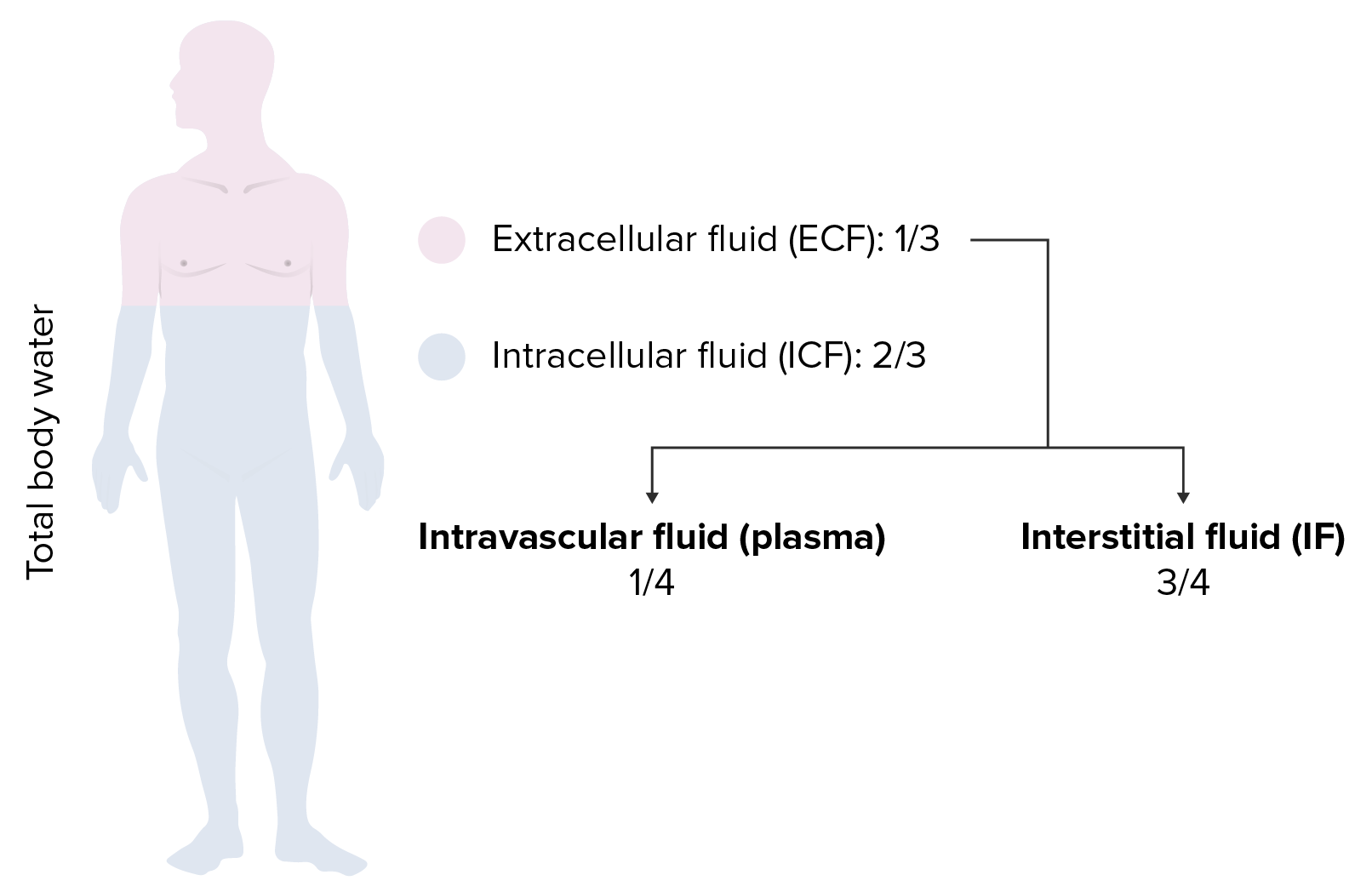Playlist
Show Playlist
Hide Playlist
Perioperative Care: Fluids and Electrolytes
-
Slides Fluids electrolytes Special Surgery.pdf
-
Download Lecture Overview
00:01 Welcome back. 00:02 Thanks for joining me on this discussion of fluids and electrolytes in the section of perioperative care. 00:09 Fluids and electrolytes are incredibly important to maintain daily physiologic function, but also it’s incredibly high yield for standardized examinations. 00:19 So, I hope you're paying close attention. 00:22 Let's start the discussion by an estimation of total body water. 00:27 Total body water when expressed in liters is approximately two thirds or 0.6 times your total body weight in kilograms. 00:36 For example, a standard 70 kilo patient would have approximately 42 liters of fluid. 00:42 That's a lot of fluid. 00:44 Now, the distribution of the fluid is equally important. 00:48 The vast majority of that 42 liters of fluid is actually intracellular to the tune of two-thirds. 00:56 One-third of your total body water is actually extracellular and only a very small percentage one-third of one-third is contained in your intravascular or circulating volume. 01:08 When you do all the math, you figure that 7% of your total body weight is actually intravascular. 01:14 That's how we get the value of approximately 5 liters of fluid in your total circulating volume. 01:23 Our body does an amazing job of maintaining intake and output homeostasis. 01:29 On a daily basis, we approximately ingest 500 in – or potentially excess depending on how much water you drink. 01:37 In our food, we probably take in about 800 cc of fluid. 01:41 And normal cellular processes contribute about 300 cc. 01:46 In our output, we make about 500 cc of urine a day. 01:50 Our skin and insensible losses account for approximately 500 cc. 01:55 Breathing alone, because of the humidity, loses about 400 cc. 01:59 And our stool, although mostly without fluid, still contains about 200 cc. 02:05 And that's an important point, because patients with diarrhea can lose fair amount of fluid through their stools. 02:14 Electrolytes are incredibly important and will be the focus of the majority of this lecture module. 02:20 Remember, potassium is mostly intracellular. 02:24 If you forget that, all you have to do is look at standard chemistry laboratory values. 02:29 The potassium is rarely ever greater than 4. 02:33 Aldosterone is a very important – has a very important mechanism in the distal collecting system to maintain not only fluid homeostasis, but affect the potassium channels. 02:45 Aldosterone increases sodium reabsorption at the expense of excreting potassium. 02:53 This allows it to maintain electrical neutrality because otherwise we would have entropy. 02:59 Potassium-sparing diuretics, however, antagonize the action of aldosterone on potassium.
About the Lecture
The lecture Perioperative Care: Fluids and Electrolytes by Kevin Pei, MD is from the course Special Surgery.
Included Quiz Questions
The Na-K-ATPase pumps sodium ions outside and potassium ions inside. In this process, what is the net amount of positive charge removed each time from the intracellular space?
- One
- Two
- Four
- Zero
- Three
Potassium-sparing diuretics have which of the following effects on potassium?
- Inhibiting the effect of aldosterone, which increases potassium retention
- Inhibiting the effect of angiotensin II on potassium
- Inhibiting the effect of ADH on potassium
- Increases the effect of aldosterone on potassium
- Increases the effect of renin on potassium
Customer reviews
5,0 of 5 stars
| 5 Stars |
|
1 |
| 4 Stars |
|
0 |
| 3 Stars |
|
0 |
| 2 Stars |
|
0 |
| 1 Star |
|
0 |
Very clear, simple and easy to understand. And there is a relative translation which is suitable for beginners





